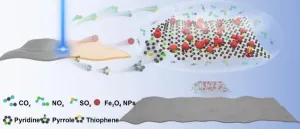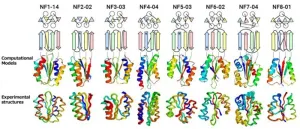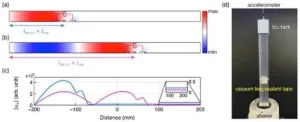(Press-News.org) Findings challenge the traditional view that antimicrobial resistance (AMR) emerges from pathogens that acquire new mutations
Samples from ICU patients suggest that instead, highly diverse pathogen communities harbour pre-existing resistant genotypes
The results suggest that interventions aimed at limiting the spread of bacteria between patients may provide a powerful approach to combat AMR.
A research study led by the University of Oxford provides a transformational new insight into how antimicrobial resistance (AMR) emerges in patients with bacterial infections. The findings, published today in the journal Nature Communications, could help develop more effective interventions to prevent AMR infections developing in vulnerable patients.
The study’s findings challenge the traditional view that people are generally infected by a single genetic clone (or ‘strain’) of pathogenic bacteria, and that resistance to antibiotic treatment evolves because of natural selection for new genetic mutations that occur during the infection. The results suggest that instead patients are commonly co-infected by multiple pathogen clones, with resistance emerging as a result of selection for pre-existing resistant clones, rather than new mutations.
The researchers used a novel approach which studied changes in the genetic diversity and antibiotic resistance of a pathogenic bacteria species (Pseudomonas aeruginosa) collected from patients before and after antibiotic treatment. The samples were isolated from 35 intensive care unit (ICU) patients in 12 European hospitals. Pseudomonas aeruginosa is an opportunistic pathogen that is an important cause of hospital-acquired infections, particularly in immunocompromised and critically ill patients, and is thought to cause more than 550,000 deaths globally each year.
Each patient was screened for Pseudomonas aeruginosa soon after being admitted to ICU, with samples then collected at regular intervals thereafter. The researchers used a combination of genomic analyses and antibiotic challenge tests to quantify within-patient bacterial diversity and antibiotic resistance.
Most patients in the study (approximately two thirds) were infected by a single Pseudomonas strain. AMR evolved in some of these patients due to the spread of new resistance mutations that occurred during infection, supporting the conventional model of resistance acquisition. Surprisingly, the authors found that the remaining third of patients were actually infected by multiple strains of Pseudomonas.
Crucially, resistance increased by about 20% more when patients with mixed strain infections were treated with antibiotics, compared to patients with single strain infections. The rapid increase in resistance in patients with mixed strain infections was driven by natural selection for pre-existing resistant strains that were already present at the onset of antibiotic treatment. These strains usually made up a minority of the pathogen population that was present at the start of antibiotic treatment, but the antibiotic resistance genes that they carried gave them a strong selective advantage under antibiotic treatment.
However, although AMR emerged more quickly in multi-strain infections, the findings suggest it may also be lost more rapidly in these conditions. When samples from single strain and mixed strain patients were cultured in the absence of antibiotics, the AMR strains grew more slowly compared with non-AMR strains. This supports the hypothesis that AMR genes carry fitness trade-offs, such that they are selected against when no antibiotics are present. These trade-offs were stronger in mixed strain populations than in single strain populations, suggesting that within-host diversity can also drive the loss of resistance in the absence of antibiotic treatment.
According to the researchers, the findings suggest that interventions aimed at limiting the spread of bacteria between patients (such as improved sanitation and infection control measures) may be a more effective intervention to combat AMR than interventions that aim to prevent new resistance mutations arising during infection, such as drugs that decrease the bacterial mutation rate. This is likely to be especially important in settings where the infection rate is high, such as patients with compromised immunity.
The findings also suggest that clinical tests should move towards capturing the diversity of pathogen strains present in infections, rather than testing for only a small number of pathogen isolates (based on the assumption that the pathogen population is effectively clonal). This could enable more accurate predictions of whether antibiotic treatments will succeed or fail in individual patients, similar to how measurements of diversity in cancer cell populations can help predict the success of chemotherapy.
Lead researcher Professor Craig Maclean, from the University of Oxford’s Department of Biology, said: ‘The key finding of this study is that resistance evolves rapidly in patients colonized by diverse Pseudomonas aeruginosa populations due to selection for pre-existing resistant strains. The rate at which resistance evolves in patients varies widely across pathogens, and we speculate that high levels of within-host diversity may explain why some pathogens, such as Pseudomonas, rapidly adapt to antibiotic treatment.’
He added: ‘The diagnostic methods that we use to study antibiotic resistance in patient samples have changed very slowly over time, and our findings underscore the importance of developing new diagnostic methods that will make it easier to assess the diversity of pathogen populations in patient samples’
The World Health Organization has declared AMR to be one of the top 10 global public health threats facing humanity. AMR occurs when bacteria, viruses, fungi and parasites no longer respond to medicines such as antibiotics, making infections increasingly difficult or impossible to treat. Of particular concern is the rapid spread of multi-resistant pathogenic bacteria, that cannot be treated with any existing antimicrobial medicines. In 2019, AMR was associated with nearly 5 million deaths worldwide.
Professor Willem van Schaik, Director of the Institute of Microbiology and Infection at the University of Birmingham (who was not directly involved with the study) said: ‘This study strongly suggests that clinical diagnostic procedures may need to be expanded to include more than one strain from a patient, to accurately capture the genetic diversity and antibiotic resistance potential of strains that colonise critically ill patients. It also highlights the importance of ongoing infection prevention efforts that aim to reduce the risk of hospitalised patients being colonised, and subsequently infected, by opportunistic pathogens during their hospital stay.’
Sharon Peacock, Professor of Microbiology and Public Health at the University of Cambridge (who was not directly involved with the study), said: ‘Multidrug-resistant infections caused by a range of organisms including Pseudomonas aeruginosa are a major challenge for patient management in ICU settings worldwide. The findings of this study add further evidence for the vital importance of infection prevention and control measures in ICUs and hospital settings more widely that reduce the risk of acquiring P. aeruginosa and other pathogenic organisms.’
Notes for editors:
For media enquiries and interview requests, contact:
Professor Craig MacLean: craig.maclean@biology.ox.ac.uk
Dr Rachel Wheatley: rachel.wheatley@biology.ox.ac.uk
The study ‘Mixed strain pathogen populations accelerate the evolution of antibiotic resistance in patients’ will be published in Nature Communications at 10:00 am BST / 05:00 am ET on Wednesday 12 July at https://www.nature.com/articles/s41467-023-39416-2. To view a copy of the paper pre-embargo, contact Professor Craig MacLean: craig.maclean@biology.ox.ac.uk or Dr Rachel Wheatley: rachel.wheatley@biology.ox.ac.uk.
The patients who provided samples for the study were participants in the Advanced understanding of Staphylococcus aureus and Pseudomonas aeruginosa Infections in EuRopE – Intensive Care Units (ASPIRE-ICU) trial. This study, nested within routine surveillance of ICU patients in Europe aims to improve understanding of Staphylococcus aureus and Pseudomonas aeruginosa infections in Europe. More information can be found on the study website: https://www.combacte.com/trials/aspire-icu/
About the University of Oxford
Oxford University has been placed number 1 in the Times Higher Education World University Rankings for the seventh year running, and number 2 in the QS World Rankings 2022. At the heart of this success are the twin-pillars of our ground-breaking research and innovation and our distinctive educational offer.
Oxford is world-famous for research and teaching excellence and home to some of the most talented people from across the globe. Our work helps the lives of millions, solving real-world problems through a huge network of partnerships and collaborations. The breadth and interdisciplinary nature of our research alongside our personalised approach to teaching sparks imaginative and inventive insights and solutions.
Through its research commercialisation arm, Oxford University Innovation, Oxford is the highest university patent filer in the UK and is ranked first in the UK for university spinouts, having created more than 200 new companies since 1988. Over a third of these companies have been created in the past three years. The university is a catalyst for prosperity in Oxfordshire and the United Kingdom, contributing £15.7 billion to the UK economy in 2018/19, and supports more than 28,000 full time jobs.
The Department of Biology is a University of Oxford department within the Maths, Physical and Life Sciences Division. It utilises academic strength in a broad range of bioscience disciplines to tackle global challenges such as food security, biodiversity loss, climate change and global pandemics. It also helps to train and equip the biologists of the future through holistic undergraduate and graduate courses. For more information visit www.biology.ox.ac.uk.
END
Study reveals new mechanism for rapid evolution of multi-drug resistant infections in patients
2023-07-12
ELSE PRESS RELEASES FROM THIS DATE:
Blood pressure patterns in the first half of pregnancy improve early prediction of preeclampsia and gestational hypertension
2023-07-12
Routine blood pressure readings recorded in the first half of pregnancy can be divided into 6 distinct patterns that can effectively stratify patients by their risk of developing preeclampsia and gestational hypertension later in pregnancy, Kaiser Permanente researchers found.
The study, published July 12 in the Journal of the American Heart Association, showed that 6 pregnancy blood pressure trajectories seen within the first 20 weeks of pregnancy along with clinical, social, and behavioral risk factors can accurately predict and stratify risk of preeclampsia and gestational hypertension in low- to moderate-risk patients. ...
Gulf War illness caused by mitochondrial dysfunction, not inflammation
2023-07-12
Gulf War Illness (GWI) is a chronic multisymptom health condition affecting one-third of all veterans who served in the 1991 Gulf War, most of whom remain afflicted more than 30 years later. Common symptoms include fatigue, headaches, muscle aches, joint pain, diarrhea, insomnia and cognitive impairment.
The condition is believed to have been triggered by veterans’ exposure to environmental toxins. However, its exact mechanism in the body continues to be debated, making it difficult to diagnose and treat. The prevailing ...
Queen Mary-led research uncovers why people who have Down’s Syndrome age prematurely
2023-07-12
An overdosed gene on chromosome 21 causes people with Down’s Syndrome to age faster than the general population.
The molecular processes responsible for natural ageing of cells are poorly understood. Studying conditions in humans where ageing is accelerated due to genetic causes presents opportunities to learn about the mechanisms that control ageing and devise strategies to slow down the ageing process.
Adults who have Down’s Syndrome (DS) show earlier signs of ageing-related conditions: reduction in tissue regenerative capacity, alopecia, dry skin, ...
Scientists find evidence of world’s oldest glaciers
2023-07-12
Scientists have discovered the traces of the world’s oldest known glaciers, dating from 2.9 billion years ago, in rocks sitting under the world’s largest gold deposits in South Africa. This suggests the presence of continental ice caps at that time and that either the area was closer to the poles, or that parts of the Earth may have been frozen in a previously unknown “snowball Earth” period of extreme cold weather. This work is presented for the first time at the Goldschmidt geochemistry conference in Lyon, after recent peer-reviewed ...
Sea snakes may have evolved to see colors again
2023-07-12
A new paper in Genome Biology and Evolution, published by Oxford University Press, finds that the annulated sea snake, a species of venomous snake found in ocean waters around Australia and Asia, appears to have evolved to see an extended palette of colors after its ancestors lost that ability in response to changing environments.
Color vision in animals is primarily determined by genes called visual opsins. While there have been multiple losses of opsin genes during the evolution of tetrapods (the group including amphibians, reptiles, and mammals), the emergence of new opsin genes is extremely ...
Supercomputer used to simulate winds that cause clear air turbulence
2023-07-12
A research group from Nagoya University has accurately simulated air turbulence occurring on clear days around Tokyo using Japan’s fastest supercomputer. They then compared their findings with flight data to create a more accurate predictive model. The research was reported in the journal Geophysical Research Letters.
Although air turbulence is usually associated with bad weather, an airplane cabin can shake violently even on a sunny and cloudless day. Known as clear air turbulence (CAT), these turbulent ...
Sea snake vision evolved to regain color
2023-07-12
An international team of scientists examining the genetic history of sea snakes have found that the species has enhanced their colour vision in response to living in brighter and more colourful marine environments.
“Our research has found that the annulated sea snake possesses four intact copies of the opsin gene SWS1,” said PhD candidate Isaac Rossetto, from the University of Adelaide’s School of Biological Sciences who led the study.
“Two of these genes have the ancestral ultraviolet sensitivity, and two have evolved a new sensitivity to the longer wavelengths that dominate ocean habitats.
“The earliest ...
Scientists developed 180% relative bandwidth microwave absorber by ultrafast UV laser
2023-07-12
Scientists from Chinese Academy of Sciences Ningbo Institute of Materials Technology and Engineering, National Physical Laboratory (UK), The University of Manchester (UK) and National University of Singapore have developed a new approach, published in International Journal of Extreme Manufacturing (IF: 14.7), to fabricate a specifically designed wideband microwave absorption metamaterial with well-controlled electrical and magnetic characteristics on a polyethylene terephthalate (PET) substrate using ultraviolet (UV) laser irradiation.
The process involves using a UV laser to precisely control the characteristics of 2-D pattern on a specially formulated donor ...
Beyond nature's imagination: Scientists discover extensive array of protein folds unexplored in nature
2023-07-12
A groundbreaking study has shed new light on the astonishing diversity of protein structures and their folds in nature. Researchers set out to reveal the extent to which nature has explored the vast landscape of possible protein topologies. The results have unveiled an astounding array of unexplored protein folds, expanding our understanding and uncovering the depth of the protein universe.
This research has been published in the journal Nature Structural and Molecular Biology on July 3, 2023.
Proteins, ...
Bound states in the continuum is possible in the acoustoelastic coupling
2023-07-12
Let’s imagine a hypothetical scenario where two individuals are gripping a rope, each holding one end. Person A proceeds to shake the rope in an up-and-down motion, thus generating a propagating wave that travels towards person B. Now, if person C, positioned between person A and B, engages in a comparable frequency of waving motion as that of the rope’s wave, could the wave be redirected back to person A rather than reaching person B? Initially, this situation appears implausible, as person C does not physically ...






